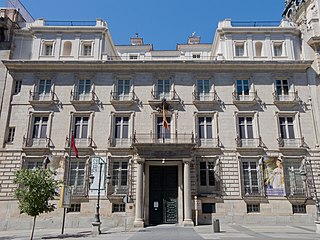
Urbano González Serrano was a Spanish philosopher, sociologist, psychologist, pedagogue, literary critic, and politician. Juan Antonio Garcia posited González was the principal developer of krausoposivitismo, a mixture of positivism and Krausism. These beliefs were determined by Yvan Lissorgues as an amalgamation of "abstract idealism of the Hegelian type and extrapolations of some philosophers and scientists".
The National Prize for Arts and Sciences is awarded annually by the Government of Mexico in six categories. It is part of the Mexican Honours System and was established in 1945. The prize is a gold medal and 520,000 pesos.

The Real Academia de Bellas Artes de San Fernando, located on the Calle de Alcalá in the centre of Madrid, currently functions as a museum and gallery. A public law corporation, it is integrated together with other Spanish royal academies in the Instituto de España.

José Custodio Cayetano García Rovira was a Neogranadine general, statesman and painter, who fought for the independence of New Granada from Spain, and became President of the United Provinces of the New Granada in 1816. He was executed a month later during the Reconquista, at the hands of Pablo Morillo.

The Royal Academy of History is a Spanish institution in Madrid that studies history "ancient and modern, political, civil, ecclesiastical, military, scientific, of letters and arts, that is to say, the different branches of life, of civilisation, and of the culture of the Spanish people". Spanish people in this regard are understood to be citizens of the Kingdom of Spain or the indigenous people of its predecessors, or their descendants. The academy was established by royal decree of Philip V of Spain on 18 April 1738.

The Archdiocese of Pamplona and Tudela is a Latin Church archdiocese of the Catholic Church located in the cities of Pamplona and Tudela in Spain.

The Spanish Royal Academy of Sciences is an academic institution and learned society that was founded in Madrid in 1847. It is dedicated to the study and research of mathematics, physics, chemistry, biology, engineering, and related sciences.
The Argentine Constitutional Reforms of 1949 were approved during Juan Domingo Perón's government. This new constitution was a major revision of the Constitution of Argentina. Its goal was to modernize and adapt the text to the twentieth century's concepts of democracy, with a bill of social rights, including better working conditions for the working class, right to education, etc. It also allowed for the indefinite reelection of the president.
The Menéndez Pelayo International Prize has been awarded since 1987 by the Menéndez Pelayo International University (UIMP) with the objective of honoring those persons whose literary or scientific work has a humanistic orientation and application, in the tradition of the University's namesake Marcelino Menéndez y Pelayo. It was established with the generous support of Eulalio Ferrer, a Spanish-Mexican entrepreneur and academician. Citizens of any Spanish- or Portuguese-speaking country are eligible. Nominations for the prize are made by universities and academies, as well as other organizations involved in the literary, humanistic or scientific cultures of those countries. The panel of judges is composed of the following persons:

The governor of Pampanga is the local chief executive of the Philippine province of Pampanga.

Antonio Alcalá Galiano y Fernández de Villavicencio, was a Spanish politician and writer who served as Minister of the Navy (1836) and Minister of Public Works (1865). He was elected a Deputy for Cádiz in 1822 and served sporadically through ten successive legislatures, until his death.

Alfonso García-Valdecasas y García-Valdecasas was a Spanish professor of civil law, lawyer, politician, and founding member of the Falange Española.

Baldomero Argente del Castillo (1877–1965) was a Spanish politician, sociologist, lawyer, economist, writer and journalist. He was a disseminator of the ideas of georgism in Spain. A member of the Liberal Party, he briefly served as Minister of Supply from 1918 to 1919.
The Echegaray Medal is the highest scientific award granted by the Spanish Royal Academy of Sciences. The award was created by Alfonso XIII at the request of Santiago Ramón y Cajal after the award of the Nobel Prize to José Echegaray and is awarded in recognition of an exceptional scientific career.











